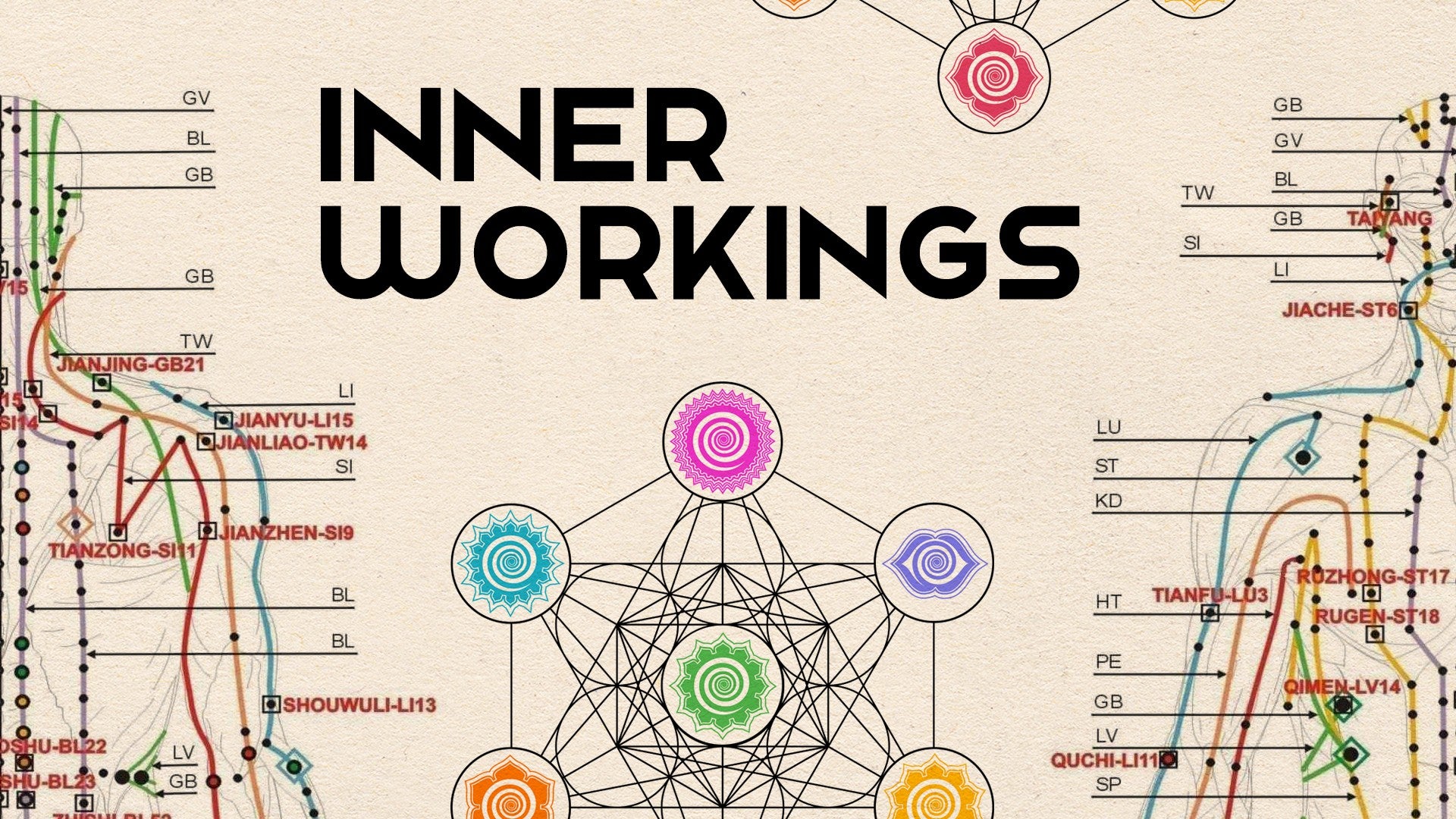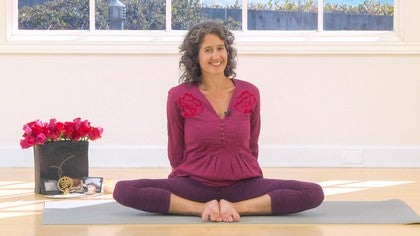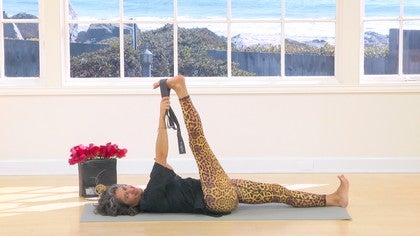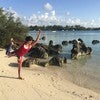Description
About This Video
Transcript
Read Full Transcript
So in our first segment, we'll start to explore the relationship of the tailbone, sacrum, ears of the pelvis, and how the femur bone plugs into that hip socket. Essentially, what's happening here effects what's happening there, so that as we start to get a deeper understanding of how we actually are designed to move, then it's easier to understand why certain things might be working or why they might not be working. It's just a really simple idea, it's part of the yogi's call for svadhyaya, self-study, okay? So what we'll do is, what we'll do is we'll just lie down, we'll do a little simple action in the tailbone, we'll do a little simple action to understand the hip rotation, and then we'll start to play with putting them together and to find out if this information is available. Again, this is just one way you might explore this, and if this way doesn't work, it doesn't meant there's anything wrong with you.
It means the lesson wasn't clear. So stay connected, so that we can be more clear. Okay, so we'll lie down. Okay, now in the interest of being helpful. (laughing) I'll roll my shirt up just a little bit.
You want to be comfortable. Heels in line with your sit bones, spread the toes wide, okay, snuggle in a little bit. And then as you're ready, inhale, and as you exhale you're gonna press your low back gently towards the earth as you draw your sit bones under and up. And as you inhale, you're gonna roll the pelvis forward, and I'm gonna exaggerate it a little bit so you can see it a little bit better. You'll roll the pelvis forward so you get this low back arch.
Okay, so continue, so as you exhale you're gonna get round, draw the sit bones under, press the low back into the earth. And as you inhale you're gonna roll the pelvis forward and let your low back arch. Okay, now the purpose of this, continue, exhale, getting round. Inhale, arching, okay. Now the play of this is just to start to get a sense of this little baby movement.
So as you're rolling the pelvis forward, we usually call this either swimsuit model or underwear model position. Your pelvis is rolling forward, you've got this low back arch happening. And as I draw my sit bones under and I'm tipping the bowl of my pelvis back, you can feel your low back pressing into the floor. So just start to get some of this anatomy. So this action, rolling the pelvis forward, letting the low back arch, my tailbone is drawing up and back.
And as I tip the pelvis back, draw the sit bones and the tailbone under, my tailbone is drawing towards my knees. See if that makes sense for you. Another word for tailbone is coccyx, and I've just used the word sit bones without defining them. Sit bones are the bottom two bones of the pelvis. In formal circles we'd call them the ischial tuberosities.
Forward, okay. Just about five more rounds like this, and one of the things to just start to get, so you're just trying to like see inside your pelvis, like, see the sacrum, see the tailbone, and what we'll do in the note section of this video we'll make sure to link to an image in case you don't have one. Okay, just a few more beats. Okay, that's probably enough. Relax, snuggle in.
Big deliberate inhale, exhale everything. Now the next action that we wanna connect to is the rotation of the hips. So we'll start out, I'll keep one foot on the floor and bring the other ankle up on top of that knee. Now keep, right now this is my left foot and this is my right knee. Keep your left foot on the floor, and as you inhale, just gently draw the right hip and knee towards your heart.
And as you exhale, let the right hip and knee move away from your heart. Okay, so as you inhale, let the right hip and knee move towards your heart, and as you exhale, let the right hip and knee move away from your heart. And now start to put some words towards this. So as this hip and this knee move towards the heart, this is what's known as internal rotation, and as the hip and the knee move away from the heart this is usually called external rotation of the hip, specifically. So internal rotation, in, inhale, external rotation, away, exhale.
A few more like this. And what we're doing here, the reason for the coordination of the breath, is we're just making more obvious what already is. Every time you inhale, your hip internally rotates, every time you exhale, your hip externally rotates. Okay, nice. Next time you come into external rotation, stay there for a moment.
And then relax that, hug the knee into the chest, wobble. Now let's just explore this side a little bit more. Okay, we'll just stay on the same side. So let the right leg extend up towards the sky, soften the right knee, now your foot is an indicator for what your hip is doing. So inhale here, and as you exhale, externally rotate your hip so that your toes turn out to the right.
And as you inhale, internally rotate your hip so your toes turn in. Okay, now continue. So external, externally rotate, it makes you look like you got duck feet. And then internally rotate, it's more like a pigeon toe action. Now, the temptation is to move from the foot and the knee because they are more mobile, so the temptation sometimes is to try to do it with the foot and the knee.
Keep those so soft as you just really, can you feel it deep down in here? Just a few more moments, see if this makes sense, see if you can sense what internal rotation feels like, what external rotation feels like. Okay, beautiful, pause in the middle, hug the knee into the chest, wobble. Release your right foot down to the floor and pause. Big deliberate inhale, exhale everything, okay.
And then we'll take the second side. Left ankle up on top of right thigh. Same idea, okay, so I'm keeping my right foot on the floor, as I inhale, left hip and knee towards heart. As I exhale, left hip and knee away. There's an inhale, left hip and knee towards heart, as I exhale, left hip and knee away.
And you're just trying to connect the language that I'm gonna use with the movement. This is one of the hardest parts of communication. Like, are we talking about the same thing? "I love you" means many different things. This is external rotation, hip and knee move away, this is internal rotation, hip and knee towards you.
So just a few more like that, just try to connect the language with the feeling, okay? Because if you, if we can get things when they're simple, then chances are when things seem to be more complicated, it will still feel simple. I'm sure I've done about the same amount, probably just shy. It's always easy to gyp the second side. Okay.
And relax, hug that knee into the chest. And then we'll find that rotation a little bit more. So you release that left leg up towards the sky. Now, by keeping the left knee slightly bent, you're, the hamstrings aren't in the equation yet, so inhale here, exhale, externally rotate. Inhale, internally rotate.
So as you externally rotate, your knee and foot, that's a foot, will follow, as you inhale your knee and foot will follow. Okay, so you sort of go like, pigeon-toed, Charlie Chaplin, and that's duck foot Charlie Chaplin. Pigeon toe, okay. And notice for you, just, like, the other piece of this is to start to notice your propensities. The most often, well, there are some people that have equal range of motion, most of us have a propensity either towards external rotation or towards internal rotation, because of how we're put together.
Like, this is an explanation of, exploration of how you are, not how you should be. I'll probably repeat that over and over and over. And not just for your sake, for mine too. Okay, hold in the external rotation. And then relax, let that knee come into the chest.
Okay, since we're supine, let's find one more thing here, okay? So let your right ankle come up on, back on top of your left thigh, and roll that hip and knee away. To get a little bit more opportunity to stretch, let the left thigh come in towards you and wobble. Now, if this already feels deep enough for you, then just keep it here, no need to bring your hands into the equation. But if it's useful, catch around the back of the left thigh.
If it's available to you easily, some of you might catch around the top of the shin. Now here's the play. The play is, can you feel the stretch of the hip and can you bring the memory of how your tailbone and sacrum work back into the situation? Okay, so inhale here, and as you exhale, draw the sit bones under, okay, so draw the sit bones under, let the left thigh come into your chest. And as you inhale, let the left knee move away from you, as you roll your pelvis forward and let your lower back arch.
Yeah, okay, exhale, curl in. Inhale, roll the pelvis forward, away from you, let the low back arch. Let's do three more like this, this time I'll really count. Exhale, come in. Inhale, arch, and just notice how it's different.
(laughing) I almost lost track only after one, that's awesome. So this stuff totally frees you from the tyranny of quantitative analysis. (laughing) Okay, pause in neutral, wobble, nice. Okay, left foot comes back down to the floor, right leg up to the sky, shake her out a little bit, and you know, add some ankle circles, 'cause they almost always feel good. Pause, and just be aware, like, the key here is really like, let it feel good as you're learning how you work.
That's actually the key lesson. If you can actually notice how good it feels to be you, everything is solved. Okay, same thing other side, left ankle up on top of right thigh, roll this hip away. Let this right thigh in, come in, wobble, now this might be deep enough for you today. Never let me force you into something that's unnecessary.
Catch around the back of the right thigh, if helpful, catch around the top of that knee if helpful. It's kinda, it's not really the knee, it's more like the k-nee, it's where the shin and the knee kind of meet each other. K-shin, k-shin is the formal word. Okay, from here, inhale, and as you exhale draw the sit bones in, wobble, and as you inhale roll the pelvis forward away and arch. Okay, and the play here, the purpose of this, about four more.
The purpose of this is just to feel that it changes the feeling in your hip, it changes the feeling in the stretch, depending on what you're doing, and that sacrum region, tailbone region, pelvic region, okay. Nice. I'm pretty sure we have one more. Okay. Relax into neutral, wobble, nicely done.
Release the right foot, release the left leg, shake her out a little bit. A couple ankle circles. And then let that knee come back down to the earth. Okay, now just pause for a moment, like, because we're gonna continue the lesson in sitting and then eventually on all fours, if you're like, I'm good, you might just stop here, just allow yourself to feel the new spaciousness in your hips from a little bit of attention. Okay.
The way I'm gonna transition is bring my knees into my chest, I'm gonna cross my ankles, roll back, and I'll roll up to sitting. Okay. So again, the point of this is to try to connect how these things go together. And this, for some reason, has always felt easier seated, and then we'll take it on all fours. And you'll see which one feels best for you.
So I'm sitting baddha konasana, the soles of my feet are touching, I'm gonna catch around my ankles. And the play here is, just before you do anything in your tailbone and the pelvis, is please start to notice how this region of the hip joints feels. So when I say hip joint, I'm specifically referring to the head of the femur, okay, that's plugging into the socket in the pelvis. Okay, so hold onto the ankles, inhale here, and as you exhale, hold on and curl the sit bones under and let yourself round, okay. Now as you inhale, please roll the pelvis forward and let your heart arch.
Okay, let's continue. So as you exhale, you're holding on the ankles and you're letting your sit bones round, do you remember being in this position when you were supine, when you were pressing your low back to the floor? So in your mind's eye, can you see your sacrum drawing under, can you see your tailbone drawing under? Like, can you see that? And as you inhale and you roll your pelvis forward, can you see your sacrum tipping forward, your tailbone lifting, your pelvic bowl tipping forward?
Okay, now, next time you get round, curling your sit bones under, can you tune your mind into how your hips feel, the space in your hips, and now as you inhale and you roll your pelvis forward, can you feel the space in your hips? And so the request here is, see if, maybe, maybe not. But as you draw your sit bones under and you get round, can you feel how there's more room, perhaps, in your hips, and as you roll your pelvis forward and you arch, can you feel how you can feel the sense of, um, compression, like, you run out of room in there? Okay. And so the play here is, can you close your eyes and can you see that as you draw your sit bones under your hips actually externally rotate, they open naturally.
And as you roll your pelvis forward and draw that tailbone up, as you arch your low back, your hips are naturally starting to want to internally rotate, so you kind of run into yourself there. See if that makes sense inside. Maybe, maybe not. But just see if you can feel that, that drawing the sit bones under externally rotates the hips a little bit. Rolling that pelvis forward naturally internally rotates.
Which is why when you approach seated postures, often, let's do this together, externally rotate, draw the sit bones under, and see if you can remember, like, rolling your hips open, like, do you remember that feeling of external rotation? Can you find that again, remember the duck foot, the Charlie Chaplin? And can you maintain that feeling of external rotation as you now, you're kind of, you're playing the realm of the opposites. You're externally rotating your hips, while you're rolling your pelvis forward. Okay, so while I'm externally rotating my hips and rolling my pelvis forward, then my heart is lifted and my hips are open.
And you'll notice that my knees don't easily touch the earth. That's 'cause my propensity, personally, in my anatomy, I'm more inclined to internal rotation. So in these external rotations, it requires, you know, me to really really like, chooka-chooka-chooka, I have to, like, work to bring those knees down. Like, I have to assist, I have to be my own prop, use my hands to bring them down, okay. Or sometimes a nice friend will come along and stand on me.
You know, my favorite. Okay, so that's how it has to work for me. You might be like, bloomp. No problem. That would mean you were generally, that would mean you were more externally rotated.
Okay, one more lesson, let's see. This may or may not be making sense, but let's find our way onto all fours. This is more subtle, but some people, it makes more sense. So you're gonna find yourselves onto all fours, now, this is gonna be almost impossible for you to see in me, this is much more of an experiential thing in you. Like, it'll be very hard to see much in what's happening in my body, so this is more about you looking at your own body.
So you come onto all fours, inhale here, and as you exhale, curl your sit bones under and let your back round into what we usually call a cat pose. And as you inhale, you're gonna roll your pelvis forward and draw your heart up into what we usually call cow pose. Okay, now, as you exhale, and you roll your sit bones under, can you tune your mind into the feeling of your hips, and I should be more specific here, the hip bones. Okay, so really into the hip bones, 'cause we can get confused about muscular stuff. Okay, so exhale, you get round, and see if you can feel that external rotation of the hip bones.
And as you inhale and you arch, can you feel the internal rotation of the hip bones? Okay, maybe, maybe not, but let's continue. So as you exhale, and by external rotation I mean there's a feeling of the hips rolling wide, that feeling that you had when you were sort of in the duck foot. And as you roll the pelvis forward, sometimes you can sense how the hip bones follow and you get this internal rotation. Okay, just like, close your eyes and just, maybe let's do three more together, so just exhale, you get round in the sit bones, it's subtle, there's a feeling of the hips rolling wide.
And as you inhale you arch and there's a feeling of the hips rolling in. Okay, two more together, just see. And please, please, no need to be frustrated if it's not obvious, we will continue to explore this together. We've got many more seasons. Okay, one more, exhale, get round.
Just see, like, close your eyes, see if you can feel that rotation in the hips that follows the drawing of the sit bones under. See if you can find the rotation of the hips that follows the arching of the back. And then let it come back to neutral and find child's pose, draw the sit bones under, walk your hands forward. And then chin into the chest, roll on back up. Okay, so we're just beginning, okay?
So just see if you can find that, like, see if you can start to feel, and I really recommend, like, if you haven't ever seen an image of what your hips and your femurs and your pelvis and sacrum look like, like, get online, it's pretty easy, Google Image Search. Thanks for being here. Love.
Inner Workings: From the Visible to the Invisible
Comments
You need to be a subscriber to post a comment.
Please Log In or Create an Account to start your free trial.















